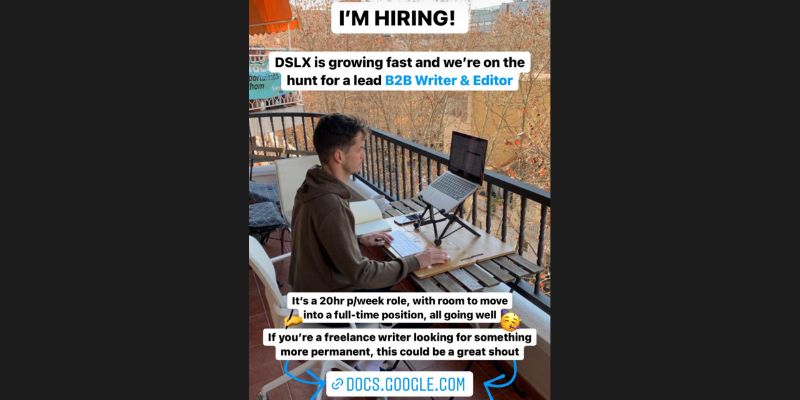How I Went From a One to a Three-Person Team
Okay, my fellow small business owners, let’s talk about building teams. And, I’m not going to sit here and tell you how to go from 10 to 20 to 30+ people, DSLX isn’t there yet. But, what I can walk you through is how you go from a one to a three-person team.
Your first few hires are crucial to the success or failure of your business. They not only contribute to your initial growth, but they pave the way for those that come after them, contributing towards company culture in ways that you cannot imagine.
This article is for my fellow freelancers struggling to meet demand and thinking your business could be bigger than just you. It’s for fearless founders ready to launch that dream they’ve had tucked under their pillows for years.
What you need to know, and what I hope to convey in this article, is you don’t have to take the leap if you don’t want to. You can build your business at your pace, one bold, brave, but calculated step at a time.
Shall we?
3 things to know when going from a one to a three-person team
I haven’t been a Growth Mentor for too long, but I’d say around 40% of my sessions have revolved around guiding freelancers through their first hires. Here’s what I know.
1. Sort your payroll options to employ and support overseas teams
Talent can be found everywhere and anywhere, at the same time it wants to go everywhere and anywhere. I don’t need to drill home the hybrid world we live in, but I will highlight the desire to travel is at an all-time high: revenge travel.
At the same time, I cannot stress enough the importance of hiring in and out of your circles, and kicking things off with a diverse team from the get-go. Diversity comes in many forms: thirteen forms in fact. But, a big one that’s enabled DSLX to reach new audiences and expand our mission is working with people across the globe.
What does this mean? You’ll need to set your business up so it’s in a position to work with people overseas, whether they’re based in a country that’s not where your business is based, or whether they want to travel to an overseas country. You’ll need to be ready for both.
A big one to consider to help you achieve working with a global team is shadow payroll. This payroll setup will enable you to send employees overseas for any time period and ensure that they’re still on their home country’s payroll, be able to pay taxes in their home country, and continue making pension contributions in their home country too.
In short, to build those first few players, ensure you’re set up to support them, no matter where they want to be or what they want to go.
More so, encourage them to go. I’m a firm believer in discovering inspiring places leads to inspiring work. Life is too short to revolve around a desk.
Even as I write this, I’ve got one full-time team member camping around Colombia, one exploring Argentina, and one who has just got home from a trip to Wales. Get out there and get inspired!
2. Scale time as you scale your people
Your first few hires don’t need to be full-time hires. Bringing on someone full-time can be daunting—for both parties. There are so many freelancers out there that don’t want to be on a full-time gig, so don’t make the mistake of pushing a full-time gig if neither party is ready for it.
In my case, every new hire started on a 10-20hr-a-week contract, and we scaled—slowly. We scaled at a pace that suited both of us and I was always transparent with my plans to scale them up in hours. Fair enough, this may take longer to find the right person with the right talent, but it’s worth the risk.
I had team members that scaled up their hours with me over the course of a year, and others that scaled up with me over the space of a few months. DSLX worked at a pace that suited each hire, and the transparency from day one helped keep everyone on the same page.

Coworking with a Barcelona-based team member at OneCoWork
3. Advertise everywhere
When I say this, I mean everywhere. Everyone and their mother should know you’re hiring. Now, there are plenty of job pools out there which are fabulous. One we use at DSLX is Remotewokr.com.
However, go beyond the job boards. You’ll find they’re massively overpopulated (Fiverr, Upwork, etc) and as a solopreneur, you can quickly be overwhelmed with applications. A few other places to consider are:
LinkedIn: This is obvious, but I need to keep it on the list. You don’t need to be funneling money down job ads, nor do you even need to formalize things as much to create a job on your company page. Start simply by publishing a post.
I published a post and linked it to a view-only Google doc. It’s actually much more personal, it does the job (excuse the pun), and doesn’t require people to fill out a ton of unnecessary steps or sign up to a new app to apply to your role—phew!
Instagram, TikTok & Twitter: Don’t underestimate your social channels, their reach, and the people following your journey. At the time of writing this article, I have around 9k Instagram followers, 14k TikTok followers, and a couple of hundred on Twitter. But, you don’t need a lot to reach new audiences if you’re offering something relevant.
My Instagram story saying I was looking for a new team member reached a couple of thousand people, and they typically only get around 400-500 views. It was being shared and DM’ed beyond what I could see. And, I found my second hire through an Instagram story. The same reach goes for TikTok—their algorithm is perhaps even more forgiving.
At the same time, you don’t need a lot of Twitter followers for one of your tweets to do well. What you do need to do is figure out your community hashtag. In the content world, hiring hashtags I’ve used are:
- #FreelanceCommunity
- #FreelanceWriter
- #WritingCommunity
Community hashtags have incredible reach.
Are there any German speaking #copywriters out there looking to take on more work? Please get in touch or tag someone you think may be interested! #DECopywriters
— rayslaterberry (@rayslaterberry) November 9, 2021
Word of mouth: In any conversation, you can bring up that you’re hiring. Word of mouth is powerful and spreads surprisingly fast. Where I’ve found success is in letting past colleagues know I’m hiring. In doing so, I’m able to tap into more relevant networks while winning introductions to people with a vote of confidence from someone I know can do great work. Breathe.
My first hire at DSLX was actually an intern I worked with in a previous role. We’d stayed in touch throughout my journey into freelancing, and I’d started to bring her into a couple of projects as she had the time while finishing up her degree.
When I knew I was ready to launch something bigger than just me I asked her what her plans were after Uni. She told me she wanted the summer to be reasonably calm and would start looking for something full-time come September.
I told her not to make any plans. I brought her on for 20 hours a week throughout the summer, and come September, I brought her on as my first full-time hire! She’s been with me ever since and every day I’m grateful for her talent and trust.
My fourth hire was an introduction from a freelancer I’d worked with in the past. I wasn’t actually looking for my fourth hire, but things aligned, and as soon as we brought her on our client base expanded and we were flying before we could run.
Universities: Universities are a fantastic hub of talent and well worth tapping into. I work closely with my previous university, Falmouth. We run an internship program, in which every 6 months we take on two interns, train them up, and bring them onto one client’s account.
We’re able to lift the quality of their work, introduce them to the world of writing professionally, and often end up working with them as they continue on their freelance journey. I remain a mentor and guide for every intern that’s been with us.
Reddit & Slack Communities: Communities are fantastic hubs of dedicated people, determined to make the most of them. We often use these communities if we ever need to up our talent pool of freelancers—for example, when we know we’re going to be expanding and need a new knowledge topic on our books.
Reddit and Slack take a bit of community management and policing to ensure you get a good fit applying for your role, but we’ve had fantastic success there. A few of my favorite communities are:
Remember, build a team you trust
That’s everything on going from a one to a three-person team. Hopefully, you’re now better equipped to start hiring for your first few roles and can take your business to the next level at a pace you’re happy with.
I’ll close out by saying you need to be hiring people you trust. There is absolutely zero point in hiring someone that you feel you’ll need to micro-manage. What’s more, don’t mix micromanagement with training. All team members will need to be trained up if you want them to do their job well, and want to step out of their day-to-day—which is the only way you’re going to be able to grow this business.
So, hire people you have faith in, and that come well-recommended. Train them up on everything; from culture to comms, project management to delivery of work. For example, my Account Manager training gets into the client-facing micro-messaging we provide on Slack to how we book meetings internally—building on our empathy value of always booking on other team members’ timezones, never our own.
Train well, so you can do it once. Dive into the minute so you don’t have to reiterate. It’ll seem like a lot, but actually, it’s just solid training at its finest and exactly what your business needs in this moment of growth.
Trust in your team and they’ll trust in you. What’s left? Go get hiring. You’ve got this.







